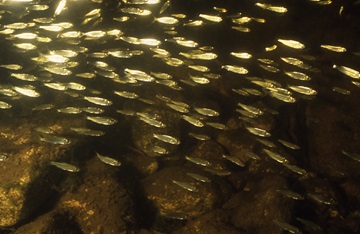Migratory Fish Runs of Connecticut
 Most migratory fish are either anadromous or catadromous. Anadromous fish spend most of their adult lives at sea, but must return to freshwater to spawn. Catadromous fish live most of their adult lives in freshwater, but must return to saltwater to spawn. Collectively these two groups are sometimes referred to as diadromous. There is only one catadromous fish species in Connecticut, the American Eel. It is found in all waterbodies in the state with the exception of the following locations:
Most migratory fish are either anadromous or catadromous. Anadromous fish spend most of their adult lives at sea, but must return to freshwater to spawn. Catadromous fish live most of their adult lives in freshwater, but must return to saltwater to spawn. Collectively these two groups are sometimes referred to as diadromous. There is only one catadromous fish species in Connecticut, the American Eel. It is found in all waterbodies in the state with the exception of the following locations:
- East Branch Farmington River and tributaries upstream of the Saville Dam in Barkhamsted.
- West Branch Farmington River and tributaries upstream of the Goodwin Dam in Hartland.
- Shepaug River and tributaries upstream of the Shepaug Reservoir in Warren.
Spawning populations of Shortnose and Atlantic Sturgeon were once found in many of Connecticut’s larger rivers but most were rendered locally extinct or "extirpated" by the early 20th century due to a variety of factors. The only known contemporary spawning population of Shortnose Sturgeon is found in the Connecticut River in the stretch from the Turners Falls Dam in Turners Falls, MA to the mouth of the river in Old Saybrook, CT. Excitingly, CT DEEP researchers recently discovered evidence of natural reproduction of Atlantic Sturgeon in the Connecticut River, suggesting the potential re-establishment of a spawning population. In addition to the Connecticut River, Atlantic Sturgeon and/or Shortnose Sturgeon have been found from May to October in the following areas:
- Housatonic River downstream of the Derby Dam in Derby.
- Quinnipiac River downstream of the Wallace Dam in Wallingford.
- Thames River upriver to Norwich.
- Shetucket River downstream of the Greenville Dam in Norwich.
Both species are listed as federally endangered and if caught must be released immediately and not injured.
More information on each of the migratory species can be found on the Freshwater Fishes of Connecticut page.


Content last updated in July 2021.

